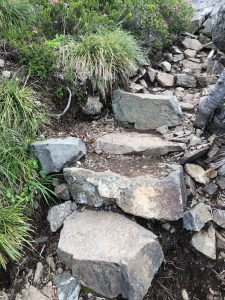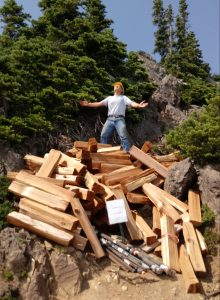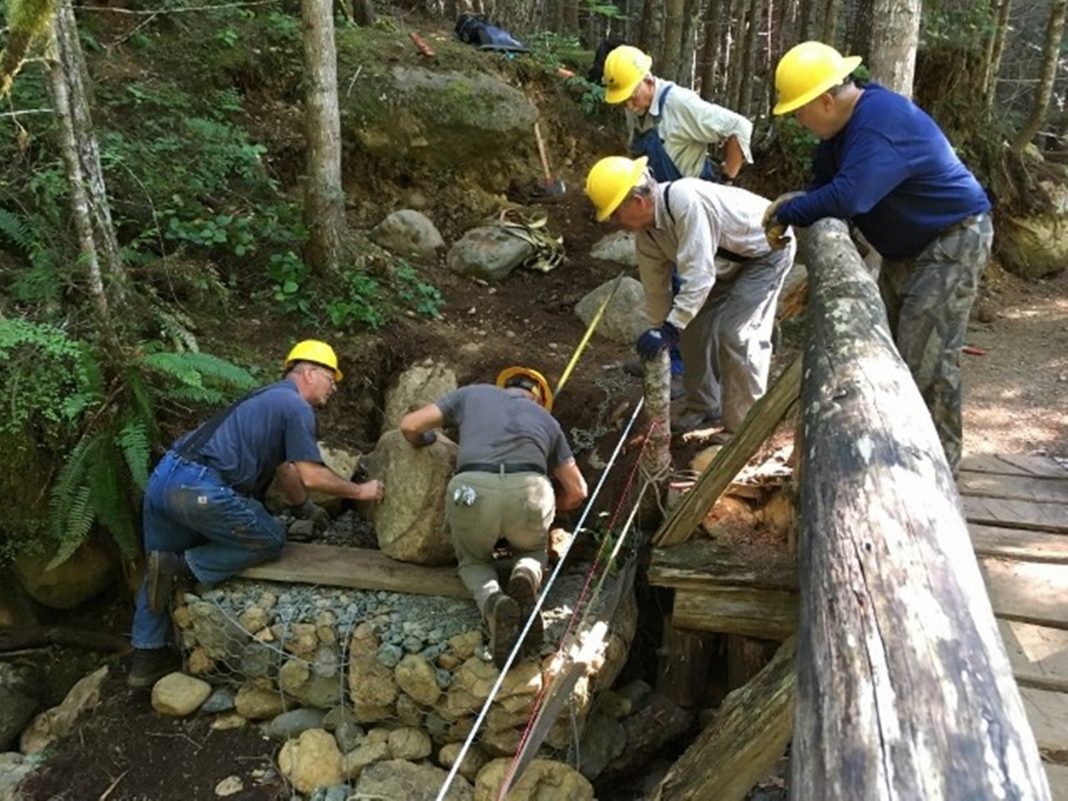Hiking the Mount Ellinor Trail has never been easy. It’s a steep trail, but the panoramic view of Lake Cushman, the Puget Sound and surrounding mountains is worth the effort. Looking down at the trail is also a wonderment.
 The first part of the upper trail involves switchbacks through forest. As you hike closer to the tree line, the trail gets steep and rocky, requiring careful foot placement. This offers an opportunity to notice and marvel at the careful and skillful trail work. Chiseled rock forms discrete staircases, neat gaps between block steps make drainage channels, and in one particularly tricky spot, wooden steps are bolted to the rock to create foot holds. The craftsmanship of this trail really stands out.
The first part of the upper trail involves switchbacks through forest. As you hike closer to the tree line, the trail gets steep and rocky, requiring careful foot placement. This offers an opportunity to notice and marvel at the careful and skillful trail work. Chiseled rock forms discrete staircases, neat gaps between block steps make drainage channels, and in one particularly tricky spot, wooden steps are bolted to the rock to create foot holds. The craftsmanship of this trail really stands out.
At certain points along the path are piles of wood and packages of rebar. Having neglected to read the sign at the trailhead, other hikers let us know what was up. The Mount Rose Trail Crew (MRTC) requested hikers help carrying the supplies up the mountain to certain drop points.

I had to find out more about this ambitious trail crew, so while my legs recuperated once we got home I made a call to the Ranger Station. I was connected to Meghan Fluharty, Wilderness and Trails Coordinator for the Olympic National Forest, Hood Canal Ranger District. Meghan is the only paid Forest Service employee of the Wilderness and Trails Program. “The Mount Ellinor trail is one of our best trails,” Meghan agrees. “The views are wonderful and you feel like you’ve worked for it.”
As for members of the MRTC, they are generous with their time and skills, but shy away from recognition. They prefer to remain anonymous out of humility and deference to the many other groups who also do great work on trails in the area. However, they allowed Meghan to share some history and photos.
“One of their trails is the Mount Ellinor Trail, one member of the crew only focuses on this trail and has dedicated himself to maintaining it,” Meghan shares. He came up with the idea of asking hikers to help him carry the wood and rebar, used to build steps. “At first he wasn’t sure if it would work, but hikers all seem to enjoy the challenge and like being able to participate.”

“The Mount Rose Trail Crew began in some capacity in 1984. It grew in numbers and became a year-round, two times per week program in 1997,” explains Meghan. “Most of the members are retired or close to retirement age, and to-date there have been three dozen members over the years. They maintain 18 different trails across the southern half of the Hood Canal Ranger District.”
Here is an excerpt from their recorded history:
“We have been described as a self-directed work group. So, while we volunteer for the Forest Service, they do not oversee our day-to-day activity. We are very familiar with ‘our’ trails, and so we decide what needs to be done, how it should be done, when it needs to be done and then we go do it.
“In addition to being self-directed, we also do not have a leader who is empowered to make group decisions. That process is democratic, and it is worth noting that selection of daily projects and especially the specifics of how the work should be done and exactly what the end result should be, often leads to spirited discussion with nearly everyone voicing an opinion. But we laugh at ourselves, because sometimes it seems that there are more opinions than there are people offering them…”

The MRTC is but one of the groups who regularly maintain trails in the Olympic National Forest. The Washington Trails Association (WTA), Backcountry Horsemen, Olympia Mountaineers, Graywolf Trail Crew and the Pacific Northwest Trails Association (PNTA) each log between 1,400 to 16,000 volunteer hours a year keeping trails in good shape.
So far in 2019, 126 miles of trails have been cleared, which includes cutting trees that have fallen across trails, retreading trails, cutting back brush, fixing drainage issues to prevent erosion, removing rocks and even replacing bridges. They also do trail construction.
The MTRC may not want recognition, but Meghan says she has received calls from many appreciative hikers who want to know how they can help. One member of the crew replied via email that a good way to help is to “be nice to the trail” by not bypassing the switchbacks and to be sure to pack out your garbage, including bagged dog poop.
“I can’t express enough how impressed I am with all that they do,” Meghan declares, “and our trails would not exist if it weren’t for all of their dedication and hard work!”
To join a trail crew contact one of the groups listed above directly, or email Meghan at meghan.fluharty@usda.gov.

















































